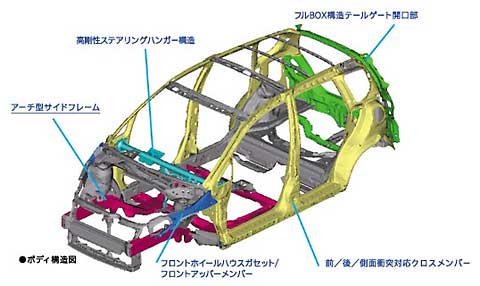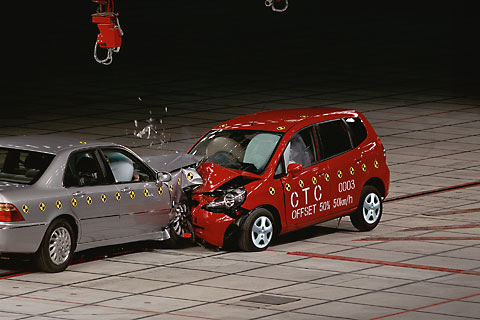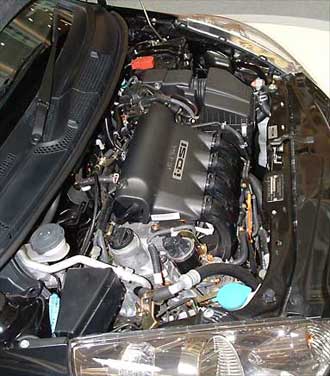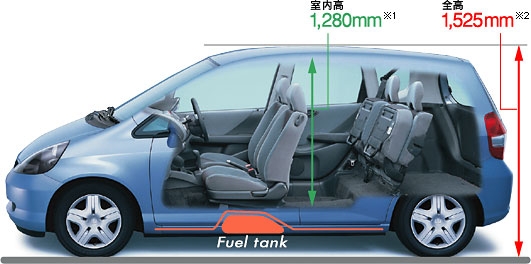
The SHEER MAGIC of the Honda Fit / Jazz

Of all the Honda models today, the Honda Fit/Jazz is quite indisputably the most successful and the most outstanding of recent years. Launched in Japan 3 years ago as the Honda Fit, it literally took that market by storm, taking the Japan's Car of the Year award for 2001 and then immediately challenging and accomplishing the near impossible task of dethroning the then undisputed and undefeated champion of 33 years, the mighty Toyota Corolla to take the top selling car in Japan for the year 2002. Since then, the Fit has continued to sell well, regularly featuring as Honda's best selling model in Japan and also managing the best selling title for some recent months i.e. August 2003 and August 2004.
The same car is sold as the Honda Jazz in the rest of the world where it is just as successful. Sold in over 70 countries worldwide, the Jazz regularly wins awards and sells very well in most of the markets in which it has been introduced. To date, the number of Fit/Jazz sold worldwide is very quickly approaching the 1 million mark, only a little over 3 years after its launch !
Such is the appeal the Fit/Jazz has that just like Honda's great models, the Civic, Accord and Integra for e.g., it has garnered legions of fans worldwide. Owners and fan clubs have sprung up wherever the Fit/Jazz is sold. Everywhere owners lovingly customizes their Fit/Jazz and proudly displays it to appreciating eyes. The aftermarket for the car is extremely healthy, with aftermarket suppliers aplenty not only from Japan but from all over the world as well.
The Temple of VTEC Asia is proud to feature our special series on this great car. This will be a multi-article series where I hope to take a look at all aspects of the Fit/Jazz to try to explain some of its magic to readers. Here in this first article of the series, I start by taking a look at the original design concept that Honda used when they created the Fit/Jazz.
Man Maximum-Machine Minimum
Honda's great principle - Man Maximum-Machine Minimum - often simply shortened to 'Man-Max' is well known to all true Honda fans. This 'Man-Max' principle has defined the underlying approach in the original design concept of the Honda Fit/Jazz, defining its DNA as the Japanese likes to call it and to me is the key that creates the magic of the Fit/Jazz. So to understand the magic of the Fit/Jazz, it is necessary to first attempt an understanding of the Man-Max principle.
 |
 |
In Honda's 'Man Maximum-Machine Minimum' principle, the car is not viewed in isolation but from a larger man-machine relationship. In this relationship, the human is placed as the most important element with the machine as subversive and whose function is to serve the human. What this dictates is that any decision made during the design of a car is made with an emphasis towards the human. In many ways this Man-Max principle is perhaps the best principle any car manufacturer can adopt and any car that is designed based on this principle will simply feel fundamentally right. This Man-Max principle is exemplified in everything that Honda does; the often talked about favoritism towards the FF layout for e.g. But perhaps the best illustration of the Man-Max principle in action is Honda's GCON technology.
The best way to understand Honda's GCON is to see it as a technology which works on the principle that it is the duty of the machine, i.e. the car, to protect the man, i.e. its occupants. To this end, GCON dictates that if there comes a time to make a choice, between the man or the machine, it is the machine who gives to the man. Thus in the unfortunate occurrence of a serious collision, Honda's Man-Max principle dictates that the machine dies so that the man can live. The car's body-shell is designed to create a sort of a 'GCON cage' (the photo on the left) which cocoons the occupants inside. Collapsible body sections are then extensively exploited so that the huge impact forces of a collision are absorbed or dissipated and thus prevented from reaching the cabin as much as possible, because it is inside the cabin where the human occupants are.
During its design phase, the Fit has gone through numerous real-life collision tests in Honda's R&D facility. The photo on the left below shows the result of one such test where a Honda Fit was sent on a '50% off-set' head-on collision with a Honda Legend and how within the limits imposed by physical laws, Honda's GCON manages to minimize the intrusion of the collision into the driving cabin by sacrificing the purely mechanical portions of the car, the engine compartment. The extend of the damage to both cars should give us a fairly good idea how fast both cars were going at prior to their collision !
Another important aspect about Honda's Man-Max principle is Honda's vision of the ownership of their cars. They view ownership of a Honda from the angle of 'total enjoyment'. What this means is that Honda sees ownership from an overall picture which includes not only the driver's angle but that of the passengers as well. Furthermore, overall enjoyment is not limited to just the journey but how the car can participate beyond and contribute to the 'life experience'. So when Honda talks about the driving experience for e.g, it doesn't come from the purely performance angle. In the first place, pure performance is not viewed as the be-all and end-all to the experience of driving a Honda, perhaps for models like the NSX or a Type-R but certainly not every Honda model. In any case, Honda has always felt that all out speed or handling are not the only measure of 'performance', and things like fuel economy, low emissions and human safety are all equally important as well. Then Honda also does not see the experience of driving their cars as just limited to the driver but the passengers are equally as important too. Finally the worth of a car is not solely for the purpose of getting from 1 place to another, i.e. not the journey alone but also how it can contribute to the whole trip.
A Type-R for example is designed to be driven to the race track and then to be driven on the track as well ! I.e. it contributes to the whole successful weekend track outing, and not just for the purpose of getting there after which it is to be parked aside while the humans uses something else for the track outing (unless of course he/she has a specialized track-car). Similarly, when back at home, Honda does not hope to see the car simply parked and left aside. Dabbling in the car - modifying and customizing it, is something Honda hopes owners will enjoy as well. So the all important overriding principle is that it is the human's experience - their enjoyment of the car which is most important and not the car itself.
The Fit/Jazz Design Concept
To understand how the Man-Max principle guided the concept and design of the Fit/Jazz, the best approach is perhaps to take extracts from the original Honda press-release for the Honda Fit when it was launched in Japan back in June 2001. The design concept for the Fit/Jazz was described in good detail in that press release.

Honda created the Fit/Jazz as a subcompact, designed and built on their new global small platform. Thus a subcompact design is the primary characteristic of the Fit/Jazz and the emphasis is on 'superior space efficiency' - i.e. squeezing the maximum possible 'useful space' out of the small body through innovative packaging and new technologies & developments. The term 'useful space' means space which can be used by the human versus what might be called 'wasted space' which is space required by the mechanicals. Key features listed in the press-release includes the new i-DSI engine, a spacious interior, variable seating arrangements, very flexible carrying capability and an innovative & original styling. Honda's target for the Fit/Jazz is to 'set the new benchmark for the small car'. Thus in its class the Fit/Jazz delivers the largest interior cabin space while its chassis sets new levels in safety. The new 1.3l i-DSI engine that was originally launched with the Fit/Jazz sets new standards in environmental efficiency and fuel economy with mileage as good as 24km/l ! The 1.5l version introduced later delivers almost as stunning fuel economy (20km/l) and low emission levels but spec'ed and tuned for sportier driving. With the Fit/Jazz, Honda wants to showcase their 'SMALL MAX' series - designs based on their new 'global small platform', which are small in size but offers the maximum in interior space, fuel economy, low emissions, 'enjoyment' (i.e. the whole driving experience) and so forth :- i.e. the things that counts.
Exterior Design

The design concept used for the Fit/Jazz's exterior is based on what Honda calls the 'ZENSHIN Cabin Form'. In the context of the Fit/Jazz, the word 'Zenshin' translates literally to 'forward advance' or in english term 'progressing forward'. This is used to convey the 'futuristic vision' of the Fit/Jazz, i.e. as representative of designs for future generations of Honda models.
Honda sees the mechanical aspect of the car as being of two main portions. The interior is the important portion as it is where the humans are seated. Everything else is considered the exterior, chassis, engine bay, suspension, etc. With 'Zenshin cabin form', Honda starts with the interior, i.e. the passenger's cabin space, so the exterior is actually designed around the creation of the large interior passenger cabin. Other key design objectives for the exterior is a sporty image which enhance the ownership experience and encourages the aftermarket customization of the car as well as world-class fuel economy and emissions and of utmost importance, the best level of safety standard for its class and beyond.
Key to achieving the interior objective is the short nose design of the Fit/Jazz's exterior, which takes up minimal space for the engine compartment and thus liberating maximum space out of the subcompact design for the interior. The overall exterior motif features smooth flowing lines to create a aerodynamically efficient and sporty looking car which is also a key element to delivering the world-class fuel economy. To complement the lifestyle approach of the Fit, unique and for Honda, adventurous colours are offered during its launch in Japan such as 'Iris Red Pearl' (pink) and pastel shades of red, blue and green.

Interior Design
The design of the interior cabin space received a lot of attention since this is where the human occupants are located. The idea is to enhance the driving and riding experience as much as economically possible. The basic requirement is a roomy and comfortable cabin and to achieve this, several key technologies and design features are adopted to deliver a class leading cabin space for small cars.
A crucial element is the newly developed compact L-series engine which is coupled to the latest development of the excellent Multimatic (CVT) gearbox. A new simplified 'high performance' (Honda's words) front strut suspension and a new 'arch-type' side frame completes the front nose design to offer a new level in fuel economy and safety within a short and small engine compartment. A new center (fuel) tank layout (positioning of the newly developed flat fuel tank inside a caged structure located in the middle of the underside) and the adoption of a compact rear 'H' type torsion beam suspension completes the rest of the exterior and they minimize intrusion into the interior cabin space, creating a uniformly low and nearly flat floor and thus increases the internal height of the interior cabin to 1,280mm or around 4 feet 3 inches. All these allows the creation of an internal cabin space which exceeds the class standard and in Honda's words, 'guarantees a comfortable interior space'.
The interior noise level is lowered by first minimizing the intrusion of outside noise into the cabin. This is achieved via a new 'double seal' design for the doors and rear hatch. The doors and interior structure has also been designed with characteristics which enhances their sound insulation properties thus further shielding the cabin from outside noise. All these creates an interior cabin which is relatively roomy, comfortable and conducive to the journey, both for the driver as well as the passengers.
Interior Packaging


The theme for the interior cabin itself pursues what Honda calls a 'sporty and personal' theme and the objective is to create a high quality interior which again exceeds the standard for its class. Honda calls the styling of the interior cabin a 'dynamic layered style', and adopted the broad motif of a bold parabola (compare the photo of the dash to its concept drawing) for the main dashboard which is designed to project a sense of integration and sportiness. Liberal use of metallic aluminum panels and aluminum based highlights, a new 3 meter instrument cluster and steering wheel design, and an audio system which is integrated into the dash provides the detailing in the theme. Even the fabric is selected to enhance the ergonomically designed seat and internal panels.
The star mechanical feature in the interior cabin is of course the new Ultra Seats. Designed to have supreme folding flexibility, the Ultra-Seats is designed to offer a wide range of storage configurations. Honda differentiates four separate mode; Utility, Long, Tall and Refresh, each achieved by a different method of folding the rear and front seats.
To get Utility-mode, we fold the back seats down. Removal of the rear head-rest is optional and depends on how far back the front seats have been pushed. The rear seats fold down flush into the low floor and creates a flat space over 1,720mm (5 feet) square in size. Next, Long-mode is created by the additional folding down of the front passenger seat. Unlike standard front seats, the Fit/Jazz front seats are foldable all the way down to a fully horizontal position and when done in conjunction with the utility mode offers the ability to hold objects as long as 2,400mm (~8 feet).

Tall-mode is created by the unique ability of the Fit/Jazz's rear seat's bottom, the seating portion, to be folded up. The actual sitting portion of the seats can be folded upwards snugly against the back rest portion and this opens up the whole floor to offer storage for objects as high/tall as 1,280mm (over 4 feet) such as plants and golf bags standing upright. In this case, an FF configuration and a new flat exhaust design allowed Honda to virtually eliminate the center tunnel and offer a nearly flat cabin floor and is key the Tall-mode configuration. Finally Refresh-mode simply refers to the folding down of just the front seats with their head rests removed. This creates a long flat resting area and allows the driver and front passenger to lie back fully down for a refreshing rest or sleep (and hence the name).
To complement this superb flexibility, the doors of the Fit/Jazz are designed to open wide. Each door has three distrinct opening stages, the last stage opening the doors by approximately 70 degrees which facilitate getting in and out and offer the widest leeway to load unwieldy and bulky goods.
Conclusion

As can be seen, Honda had put in a lot of careful attention into the original design concept of the Fit/Jazz. Hopefully this article has given readers an idea of the Fit/Jazz'es design objectives and in the process understand more about this wonderful car. This article probably does not read like a typical TOVA article because of the liberal quotations from the original Honda press release. This is because I want to clearly put forward the design concepts and objectives that Honda were working with when they designed the Fit/Jazz, because this wonderful car has also attracted its share of misunderstandings. In the next article of this series however, I hope to get back to our roots when I take a look at the variants of the Fit/Jazz available as well as a close look at the new Lseries engine and its design concept and objectives.
WongKN
January 2005
© Temple of VTEC Asia